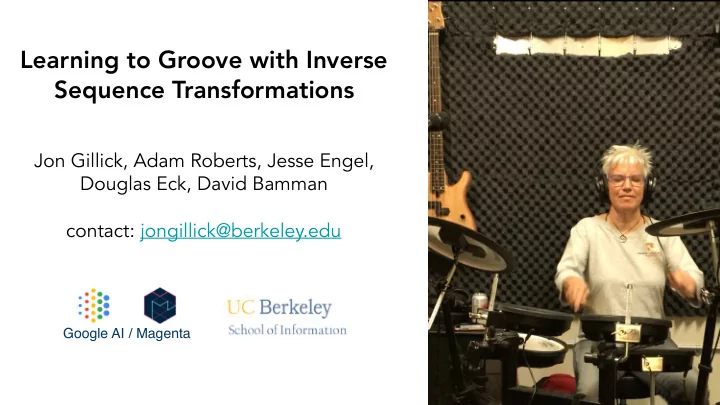

Learning to Groove with Inverse Sequence Transformations Jon Gillick, Adam Roberts, Jesse Engel, Douglas Eck, David Bamman contact: jongillick@berkeley.edu Google AI / Magenta
Questions • How well can we model drum performances with machine learning? • Can we use these models to make practical tools that give control to users?
Challenges in Editing Electronic Drums It is time consuming to edit ● the precise timing and volume of each note. Our ears connect with human ● performances. Not everyone can play drums, ● and recording drum kits is challenging and expensive.
Some Components of a Performance
Contributions • We build Machine Learning models that condition on either a score or a groove, generating the other. • We collected and released the Groove MIDI Dataset of professional drum performances for modeling.
Models Humanize Model Architecture: Variational Autoencoder ( VAE ) or Variational Information Bottleneck ( VIB ) with recurrent encoders/decoders
Models Tap2Drum Model Architecture: Variational Autoencoder ( VAE ) or Variational Information Bottleneck ( VIB ) with recurrent encoders/decoders
Results: Listening Tests Seq2Seq Real KNN Percent of Wins Humanized Humanized Infilling Tap2Drum (vs KNN) (vs Real) (vs Real) (vs Real)
Groove Model Demonstration
Drumify Model Demonstration
Questions for the Future ● How do professionals and/or amateur musicians experience working with these tools? ● How can/should we facilitate collaborations with the expert creators (such as drummers) that enable this kind of research? ● What specifically do these models learn? What biases do they capture, and how does this inform future data collection?
Thank you! g.co/magenta/groovae Stop by our poster: 6:30pm, Pacific Ballroom #242 for audio examples, interactive demos, and more! Google AI / Magenta Images Drummer by Luis Prado from the Noun Project Drum Machine by Clayton Meador from the Noun Project
Recommend
More recommend